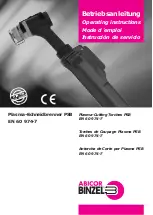
Page of 24
13
OPERATION
• High voltage danger from power source! Consult a qualified electrician for proper
installation of receptacle. This cutter must be grounded while in use to protect the operator
from electrical shock.
• Do not remove grounding prong or alter the plug in any way. Use only the supplied adapter
between the welder's power cord and the power source receptacle. Make sure the POWER
switch is OFF when connecting your welder's power cord directly to a properly grounded
120 VAC, 60 Hz, single phase, 20 amp input power supply.
1. POWER SWITCH
The power switch supplies electrical current to the welder. Whenever the power switch is in the ON
position, the welding circuit is activated. ALWAYS turn the power switch to the OFF position and
unplug the welder before performing any maintenance.
2. VOLTAGE SELECTOR
The voltage selector controls the welding voltage/heat. This unit has a two position voltage control.
Refer to the label inside the welder side door for recommended voltage selector settings for your
welding job.
3. WIRE SPEED CONTROL
The wire speed control adjusts the speed at which the wire is fed out of the welding torch. The wire
speed needs to be closely matched (tuned-in) to the rate at which it is being melted off. Some things
that affect wire speed selection are the type and diameter of the wire being used, the heat setting
selected, and the welding position being used. Refer to the label inside the welder side door for
recommended wire speed settings for your welding job.
NOTE:
The wire will feed faster without an arc. When an arc is being drawn, the wire speed will
slow down.
4. HOLDING THE TORCH
The best way to hold the welding torch is the way it feels most comfortable to you. While practicing
with your new welder, experiment holding the torch in different positions until you find the one that
seems to work best for you.
5. POSITION OF THE TORCH TO THE WORK PIECE
There are two angles of the torch nozzle in relation to the work piece that must be considered when
welding.
5.1. Angle can vary, but in most cases the optimum angle will be 60 degrees, the point at which the
torch angle is parallel to the work piece. If angle A is increased, penetration will increase. If angle A
is decreased, penetration will decrease also.
5.2. Angle B can be varied for two reasons: to improve the availability to see the arc in relation to
the weld puddle and to direct the force of the arc.
Содержание FC135T
Страница 20: ...Page of 24 20 ELECTRICAL DIAGRAM...
Страница 21: ...Page of 24 21 DIAGRAM PARTS LIST...










































